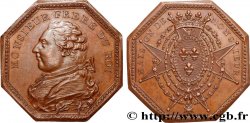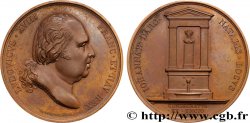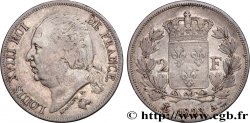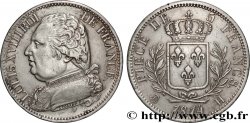Live auction - fme_518317 - LOUIS XVIII Médaille pour l’industrie, remise à Amand-Samson Bosquillon
You must signin and be an approved bidder to bid, LOGIN TO BID. Accounts are subject to approval and the approval process takes place within 48 hours. Do not wait until the day a sale closes to register. Clicking on "BID" constitutes acceptance of the terms of use of cgb.fr private live auctions.
Bids must be placed in whole Euro amounts only. The sale will start closing at the time stated on the item description; any bids received at the site after the closing time will not be executed. Transmission times may vary and bids could be rejected if you wait until the last second. For further information check the Live auction FAQ
All winning bids are subject to a 18% buyer’s fee.
All winning bids are subject to a 18% buyer’s fee.
| Estimate : | 10 000 € |
| Price : | 6 500 € |
| Maximum bid : | 9 005 € |
| End of the sale : | 05 March 2019 18:36:43 |
| bidders : | 2 bidders |
Type : Médaille pour l’industrie, remise à Amand-Samson Bosquillon
Date: 1823
Mint name / Town : 75 - Paris
Metal : gold
Diameter : 56 mm
Orientation dies : 12 h.
Engraver GAYRARD Raymond (1777-1858) / CAQUÉ Armand Auguste (1795-1881)
Weight : 136,7 g.
Edge : inscrite : AMAND SAMSON BOSQUILLON, FABRICANT DE CACHEMIRES A PARIS. LA REÇUE DE LA MAIN DU ROI LE 23 OCTOBRE 1823.
Coments on the condition:
Cette médaille présente de très beaux reliefs malgré des traces de nettoyage dans les champs (hairlines). Petites marques d’usure sur certains points hauts. Présence de coups et rayures
Predigree :
Exemplaire provenant de la collection R.P.
Obverse
Obverse legend : LOUIS XVIII - ROI DE FRANCE.
Obverse description : Tête de Louis XVIII à droite, signé : GAYRARD F..
Reverse
Reverse legend : ENCOURAGEMENTS ET RÉCOMPENSES - À L’INDUSTRIE // MDCCCXXIII.
Reverse description : La France couronnée et l'Industrie avec ses attributs en arrière plan, signé sur la plinthe : REFAIT PAR CAQUE et à l’exergue : DEPUYMAURIN. D..
Commentary
Cette médaille fut remise des mains du roi Louis XVIII à Amand-Samson Bosquillon de Marigny le 25 octobre 1823 pour l’encourager dans sa fabrication de cachemires à Paris. Bosquillon, baptisé le 15 novembre 1779 à Clermont dans l’Oise, est le fils de Jacques Louis Bosquillon de Marigny, avocat en parlement et conseiller du roi, et Angélique Parmentier de la Motte. Toujours vivant en 1848, l’inventaire après décès de sa femme, Claudine Lupin, indiquait qu’il habitait Montmartre au numéro 6 de la rue des Rosiers.
Concernant son parcours professionnel et d’après le “Rapport du jury central sur les produits de l'industrie française exposés en 1834” établi par le Baron Charles Dupin, le nom d’Amand-Samson Bosquillon “se rattache avec honneur à la création du châle de cachemire en France. Sans jamais ralentir son zèle, il a provoqué, encouragé tous les perfectionnements, les a fait mettre en pratique, et par là s’est maintenu toujours à la hauteur des progrès. Il exploite avec succès tous les genres de châles qui caractérisent la fabrique de Paris; il occupe le premier rang par l’importance de ses productions et l’étendue de son commerce à l’intérieur ainsi qu’à l’étranger. La médaille d’or qu’il obtint en 1823 [cette médaille] lui fut rappelée en 1827, le jury la confirme en 1834.” Il est également connu pour avoir apporté des perfectionnements à la machine Jacquart. Un certificat de demande de brevet d’invention et perfectionnement a été déposé en 1840.
Ce revers est initialement réalisé par B. Duvivier, vers 1797-1798, avec à l’exergue la légende “AUX ARTS UTILES / REP. FR.”, d’où la mention sur la ligne d’exergue “ REFAIT PAR CAQUÉ” et sous le millésime “DE PUYMAURIN. D.”.
Concernant son parcours professionnel et d’après le “Rapport du jury central sur les produits de l'industrie française exposés en 1834” établi par le Baron Charles Dupin, le nom d’Amand-Samson Bosquillon “se rattache avec honneur à la création du châle de cachemire en France. Sans jamais ralentir son zèle, il a provoqué, encouragé tous les perfectionnements, les a fait mettre en pratique, et par là s’est maintenu toujours à la hauteur des progrès. Il exploite avec succès tous les genres de châles qui caractérisent la fabrique de Paris; il occupe le premier rang par l’importance de ses productions et l’étendue de son commerce à l’intérieur ainsi qu’à l’étranger. La médaille d’or qu’il obtint en 1823 [cette médaille] lui fut rappelée en 1827, le jury la confirme en 1834.” Il est également connu pour avoir apporté des perfectionnements à la machine Jacquart. Un certificat de demande de brevet d’invention et perfectionnement a été déposé en 1840.
Ce revers est initialement réalisé par B. Duvivier, vers 1797-1798, avec à l’exergue la légende “AUX ARTS UTILES / REP. FR.”, d’où la mention sur la ligne d’exergue “ REFAIT PAR CAQUÉ” et sous le millésime “DE PUYMAURIN. D.”.








 Report a mistake
Report a mistake Print the page
Print the page Share my selection
Share my selection Ask a question
Ask a question Consign / sell
Consign / sell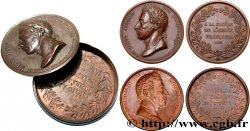
 Full data
Full data